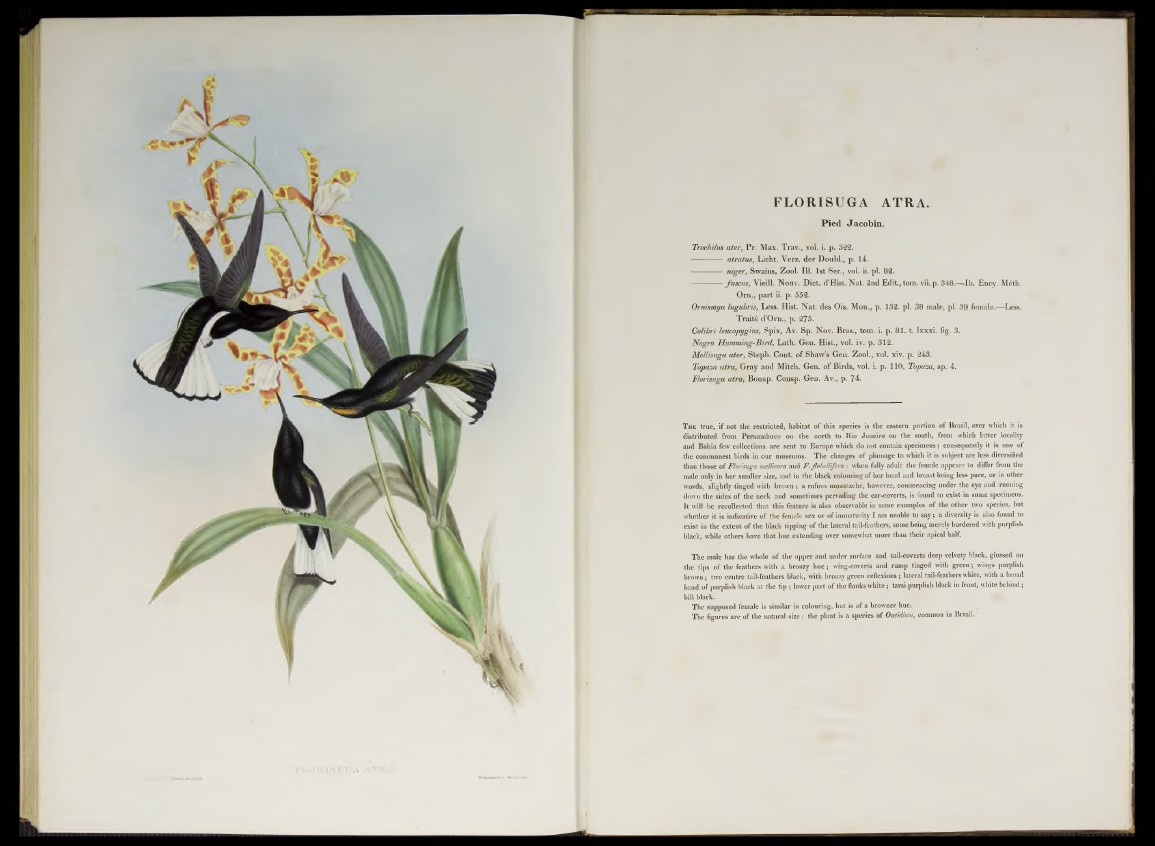
FLORISUGA ATRA.
Pied Jacobin.
Trochilus at er, Pr. Max. Trav., vol. i. p. 322.
------------atratus, Licht. Verz. der Doubl., p. 14.
------------ niger, Swains, Zool. 111. ls t Ser., vol. ii. pl. 82.
------------fuscus, Vieill. Nouv. Dict. d’Hist. Nat. 2nd Edit., tom. vii.p. 348.—Ib. Ency. Méth.
Orn., part ii. p. 552.
Ornismya lugubris, Less. Hist. Nat. des Ois. Mou., p. 132. pl. 38 male, pl. 39 femaleSLess.
Traité d’Orn., p. 275.
Colibri leucopygius, Spix, Av. Sp. Nov. Bras., tom. i. p. 81. t. lxxxi. fig. 3.
Neg ro Humming-Bird, Lath. Gen. Hist., vol. iv. p. 312.
Mellisuga ater, Steph. Cont. of Shaw’s Gen. Zool., vol. xiv. p. 243.
Topaza atra, Gray and Mitch. Gen. of Birds, vol. i. p. 110, Topaza, sp. 4.
Florisuga atra, Bonap. Consp. Gen. Av., p. 74.
T h e true, if not the restricted, habitat of this species is the eastern portion of Brazil, over which it is
distributed from Pernambuco on the north to Rio Janeiro on the south, from which latter locality
and Bahia few collections are sent to Europe which do not contain specimens; consequently it is one of
the commonest birds in our museums. The changes of plumage to which it is subject are less diversified
than those of Florisuga mellivora and F. Jlabellifera : when fully adult the female appears to differ from the
male only in her smaller size, and in the black colouriug of her head and breast being less pure, or in other
words, slightly tinged with brown ; a rufous moustache, however, commencing under the eye and running
down the sides of the neck and sometimes pervading the ear-coverts, is found to exist in some specimens.
It will be recollected that this feature is also observable in some examples of the other two species, but
whether it is indicative of the female sex or of immaturity I am unable to say; a diversity is also found to
exist in the extent of the black tipping of the lateral tail-feathers, some heing merely bordered with purplish
black, while others have that hue extending over somewhat more than their apical half.
The male has the whole of the upper and under surface and tail-coverts deep velvety black, glossed on
the tips of the feathers with a bronzy hue; wing-coverts and rump tinged with green; wings purplish
brown; two centre tail-feathers black, with bronzy green reflexions ; lateral tail-feathers white, with a broad
band of purplish black at the tip ; lower part of the flanks white; tarsi purplish black in front, white beliind;
bill black.
The supposed female is similar in colouring, but is of a browner hue.
The figures are of the natural size: the plant is a species of Oncidium, common in Brazil.